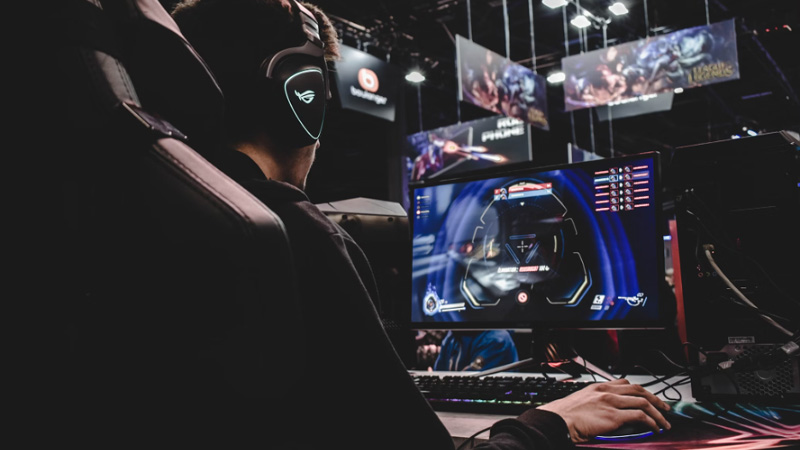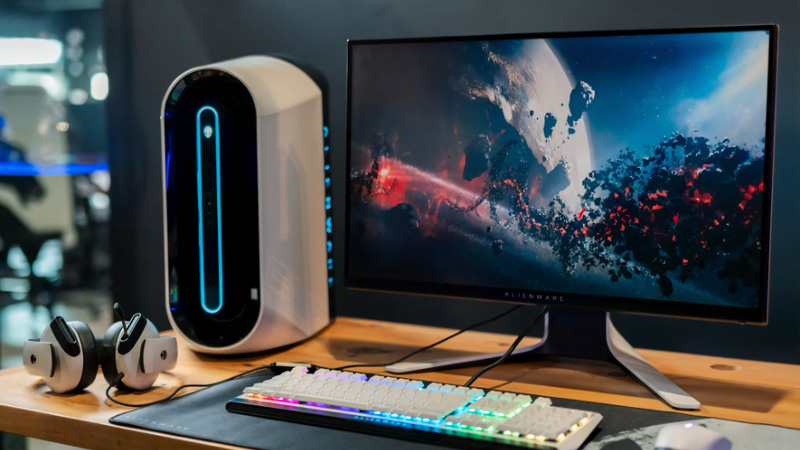
16:9 VS 21:9 VS 32:9 Monitors: Which Offers the Ultimate Gaming Experience
The gaming world will never be the same.
Back in the day, gaming was a pixelated playground of 8-bit adventures and CRT screens, where imagination filled in the gaps and every joystick click was a leap into a blocky yet boundless universe.
Nowadays, every pixel and millisecond counts. The quest for the ultimate immersive experience is unending.
Gamers constantly seek the next significant upgrade to transport them deeper into their virtual worlds. Among the most debated topics in this quest is the choice of monitor aspect ratio. Enter the battlefield of 16:9, 21:9, and the ultra-wide 32:9 monitors. Each promises unique advantages, but which truly offers the ultimate gaming experience?
Dive in as we dissect these contenders and help you find the perfect screen to elevate your gameplay to extraordinary new heights.
1. Aspect Ratio Unveiled: The Battle for the Perfect Screen
Aspect ratio refers to the proportional relationship between the width and height of a display screen or image. It is typically expressed as two numbers separated by a colon, such as 16:9 or 4:3, representing the width and the height, respectively. This ratio determines the shape and viewing area of the screen, influencing how content is displayed and experienced.
These ratios provide an expansive horizontal field of view, enhancing users’ ability to multitask and immerse themselves in wide-format content.
The choice of aspect ratio can significantly impact user experience, whether for cinematic movie watching, productivity tasks, or the high demands of modern gaming.

2. 16:9 Aspect Ratio: The Gold Standard of Modern Displays
The 16:9 aspect ratio is a widescreen format commonly used in modern displays, including televisions, computer monitors, and smartphones. This ratio indicates that the screen width is 16 units for every 9 units of height, providing a balanced and visually appealing display. Widely adopted since the early 2000s, the 16:9 aspect ratio has become the industry standard, replacing the older 4:3 aspect ratio that dominated earlier screens.
PROS
- Versatility and Compatibility:
The 16:9 aspect ratio applies to a wide range of content. Most modern video content, including movies, TV shows, and online videos, is produced in this format. This compatibility ensures that viewers can enjoy content without black bars or cropping, providing a seamless viewing experience.
- Optimal for Gaming and Multimedia:
16:9 is particularly well-suited for gaming and multimedia consumption.
It offers a wide field of view, enhancing gamers’ immersive experience. Many games are designed with this aspect ratio in mind, allowing players to enjoy detailed graphics and expansive environments.
- Widespread Availability:
Due to its popularity, 16:9 monitors and screens are widely available in various sizes and price ranges. This availability makes it easy for consumers to find a display that fits their needs and budget.
CONS
- Limited Vertical Space:
One of the main drawbacks of the 16:9 aspect ratio is its limited vertical space, which can be a disadvantage for productivity tasks. A taller aspect ratio might be more beneficial for activities such as coding, writing, or working with large spreadsheets.
- Not Ideal for All Content:
It may not be ideal for older content or specialized formats. Older television shows and some professional applications, such as photography or design work, may require different aspect ratios for optimal viewing and editing.
- Compromise Between Ultra-Wide and Traditional:
While the 16:9 aspect ratio offers a balanced viewing experience, it is a compromise between ultra-wide formats like 21:9 and the traditional 4:3. Other aspect ratios might be preferable for users seeking an even more immersive experience or needing more vertical space.

3. 21:9 Aspect Ratio: The Immersive Experience Redefined
The 21:9 aspect ratio, often referred to as ultra-wide, is a display format that significantly widens the field of view compared to the standard 16:9 ratio. This aspect ratio translates to 21 units of width for every 9 units of height, offering a panoramic display experience. Initially popularized in cinematic productions, the 21:9 ratio has made its way into gaming monitors and high-end professional displays, providing users an expansive visual experience.
PROS
- Enhanced Immersion:
The primary advantage of the 21:9 aspect ratio is its ability to create a highly immersive experience. This more expansive field of view allows gamers a more engaging and realistic gameplay experience, as the extended horizontal space provides better peripheral vision.
- Improved Productivity:
For professionals and multitaskers, the 21:9 aspect ratio offers significant productivity benefits. The extra screen real estate allows users to have multiple windows and applications open side-by-side without needing multiple monitors.
- Cinematic Viewing Experience:
The 21:9 aspect ratio closely matches the format used in most movies.
It provides an authentic cinematic viewing experience without the black bars commonly seen on 16:9 screens. This makes watching movies and streaming content more enjoyable, as the entire screen is utilized, and the viewer can fully appreciate the director’s intended framing and composition.
CONS
- Compatibility Issues:
Despite its advantages, the 21:9 aspect ratio can encounter compatibility issues with some content and applications. Not all games and videos are optimized for this ultra-wide format, which can result in black bars on the sides or stretched and distorted images. This situation can detract from the viewing experience and may require manual adjustments or third-party software to correct.
- Higher Cost:
Ultra-wide monitors with a 21:9 aspect ratio tend to be more expensive than their 16:9 counterparts. This higher cost can be a barrier for some users, particularly those who are budget conscious. Additionally, the increased screen size and resolution may require more powerful hardware, such as graphics cards, to ensure optimal performance, further adding to the overall expense.
- Space and Ergonomics:
The broader dimensions of 21:9 monitors can pose challenges regarding desk space and ergonomics. These monitors require more horizontal space, which may not be suitable for smaller desks or workspaces. Furthermore, the extended width can lead to neck strain and discomfort if not correctly positioned, necessitating careful consideration of ergonomic setup and monitor placement.

4. 32:9 Aspect Ratio: The Ultimate Ultra-Wide Gaming Frontier
The 32:9 aspect ratio, often referred to as “super ultra-wide,” takes the concept of widescreen to an extreme level. This format doubles the width of the traditional 16:9 aspect ratio, offering an expansive and panoramic display. Initially gaining traction in gaming and professional environments, the 32:9 aspect ratio delivers a truly unique viewing experience that can transform how users interact with digital content.
PROS
- Unparalleled Immersion:
For gamers, the 32:9 aspect ratio provides an extraordinary level of immersion. This ultra-wide format envelops the player’s field of vision, creating a sense of depth and realism that standard monitors cannot match. Racing simulators, flight simulators, and expansive open-world games particularly benefit from this aspect ratio, as it enhances peripheral vision and situational awareness, leading to a more engaging and lifelike experience.
- Enhanced Multitasking and Productivity:
Professionals who require substantial screen real estate for their work find the 32:9 aspect ratio invaluable. This format allows multiple applications, documents, and browser windows to be open and visible simultaneously, effectively replacing the need for dual or triple monitor setups.
- Cinematic Viewing and Creative Work:
The 32:9 aspect ratio offers a cinematic viewing experience akin to having two 16:9 screens side by side without the bezel interruption.
CONS
- Content Compatibility:
While the 32:9 aspect ratio offers numerous benefits, it also presents challenges with content compatibility. Many games, videos, and applications are not designed to support this ultra-wide format, leading to black bars on the sides, stretched images, or distorted visuals.
- High Cost and Hardware Demands:
Monitors with a 32:9 aspect ratio are typically more expensive than their narrower counterparts. The increased screen size and resolution demand more powerful hardware, particularly graphics cards, to ensure smooth performance and high-quality visuals.
- Space and Ergonomics:
The sheer width of a 32:9 monitor requires ample desk space, which can be a limiting factor for some users. Additionally, the ultra-wide dimensions can pose ergonomic challenges, as users may need to turn their heads more frequently to view different screen parts.

5. Energy Savings
Aspect ratios in display monitors significantly impact the viewing experience, offering varying screen real estate for tasks ranging from gaming to professional work.
Alongside choosing the correct aspect ratio, it’s essential to consider energy efficiency.
Energy-saving display monitors combine optimal aspect ratios with advanced power-saving technologies, ensuring users enjoy high-quality visuals while minimizing electricity consumption. Check out the ES-960-Series, which has an energy-saving design, here.

- 3D Billboards Best Combination
- Energy Saving Display 30% Design
- Ultralight Aluminum Profile Cabinet
- Standard Size: 480×320/960*960mm
- With 3 Years Warranty and 5% Spare Parts
6. Final Thoughts
Choosing the correct aspect ratio for your monitor can redefine your digital experience, especially when you’re a gamer. The 16:9 aspect ratio is the gold standard, delivering widespread compatibility and a balanced viewing experience.
Step into the future with the 21:9 aspect ratio, where immersive gaming and enhanced multitasking come to life on a cinematic scale.
For those who crave the pinnacle of immersion and productivity, the 32:9 aspect ratio offers an unparalleled panoramic experience, transforming your workspace into a boundless digital canvas.
By understanding the distinct advantages and considerations of each aspect ratio, you can make an empowered choice that elevates your digital world to new heights.
Have you made your choice?